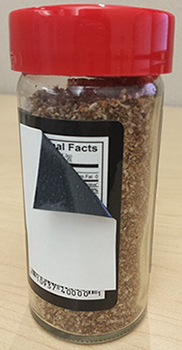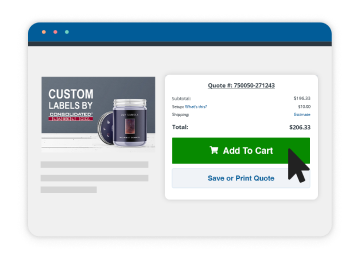Things change, mistakes happen…and sometimes we need cover-up labels to come to the rescue. Custom cover-up labels can save business owners valuable time and resources since they’re a cost-effective way to resolve printing hiccups like packaging misprints, new labeling regulations, updated barcode numbers and more. Also known as correction and blockout labels, cover-up labels are less expensive and time-consuming than reprinting an entire label, packaging, publication, etc. Find out how cover-up labels can help your business or labeling project get the right message across.

Why Cover-Up Labels Are Needed
Pretty much anything that needs to have text and graphics corrected, updated or replaced can use a cover-up label so your target audience gets accurate and timely information. To give you a better idea of how cover-up labels can help your business, below is a list of common uses.
- New or updated product ingredients
- Graphic, logo or image change
- Publication and packaging misprints
- Safety information updates (warnings, instructions, dosage quantity, etc.)
- Barcode updates and replacements
- Address change on pre-printed envelopes, marketing materials, shipping labels
- Out-of-date information
- Add or replace a QR code
- Fading text or graphics
Now that you understand some of the “whys” behind cover-up labels, let’s discuss the “how” so you can achieve successful cover-up labels.
How Do They Work?
Selecting the right material is essential for cover-up labels to better ensure that absolutely no text and/or graphics underneath the label can be seen. Below are several material options we use for printing cover-up and blockout labels.
- High Gloss Opaque Paper: This high strength paper stock is designed for quality printing at fast speeds. It has a mirror finish, special opaque barrier (e.g. a dark coating printed on the underside of the label so that it’s not see-through) and permanent adhesive. This material is ideal for many indoor environments.
- Metallic Material with Overprinting: Another choice is to overprint metalized silver paper or foil film with white ink. The metallic material acts as an opaque barrier so that the text/graphics underneath the cover-up label aren’t visible.
- Opaque Film with Barrier Coating: To achieve extremely durable cover-up labels, opaque film labels with a dark barrier undercoating are a great option. If your labels won’t be exposed to extreme temperatures, chemicals or constant moisture, high gloss opaque paper will be enough for your cover-up label needs.
Tips for Getting Cover-Up Labels
Speed is an important factor when it comes to fixing printing issues. We’ve printed custom cover-up labels for a variety of reasons (most times on tight deadlines), and can offer you some label tips to better ensure your cover-up labels do what they’re supposed to do when you need them most.
- Make sure to mention that you need cover-up labels. This may seem like a no-brainer, but it’s really important that you specifically tell us that you need cover-up labels so we can select the best material to do the job.
- When in doubt, ask for samples. We can give you a sample of blockout label material or past cover-up labels that we’ve printed so you can test it out before placing an order.
- Review the label design/information for accuracy. Double, even triple, check that every element of the label artwork is correct so that a mistake doesn’t accidentally get printed, and the labels need to be reprinted.
- Have the label artwork ready to go. When you’re on a time crunch, have your artwork 100% complete before contacting us so that a rushed order can be printed without delays – and thus no longer making it a rush order.
- Choose a permanent adhesive. Cover-up labels should have a permanent adhesive so the label is hard to peel off and reveal what’s underneath. If you have specifically requested cover-up labels from your label company, then they should automatically select a permanent adhesive.
Digital printing is an excellent choice if you need cover-up labels in a fast turnaround time. On the other hand, flexographic printing may be better suited for the job if you need a large quantity of labels (e.g. over 10,000). Not sure which printing method is right for your labeling needs? No problem, our dedicated customer service team can discuss the details of your project so you get the right cover-up labels that meet your requirements.


